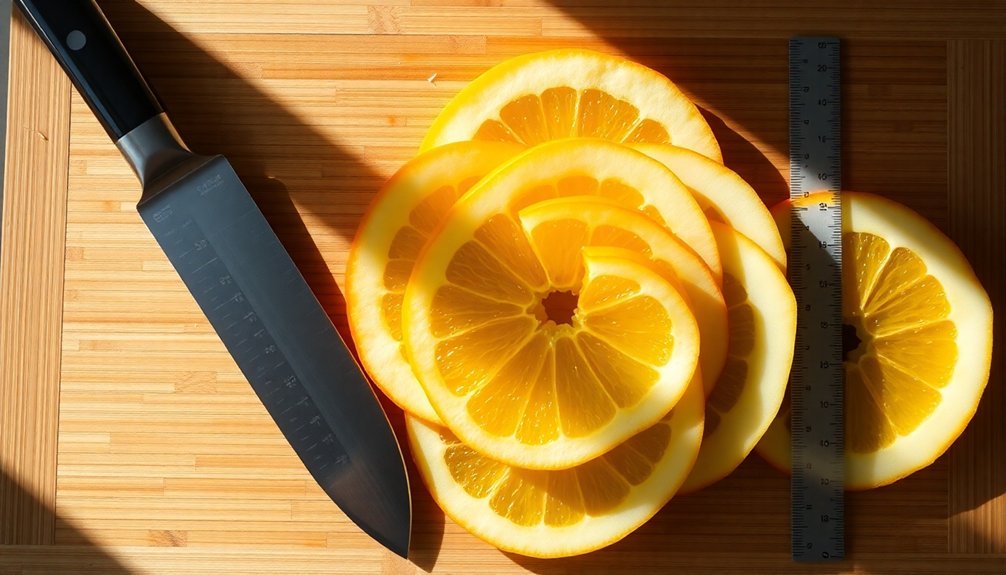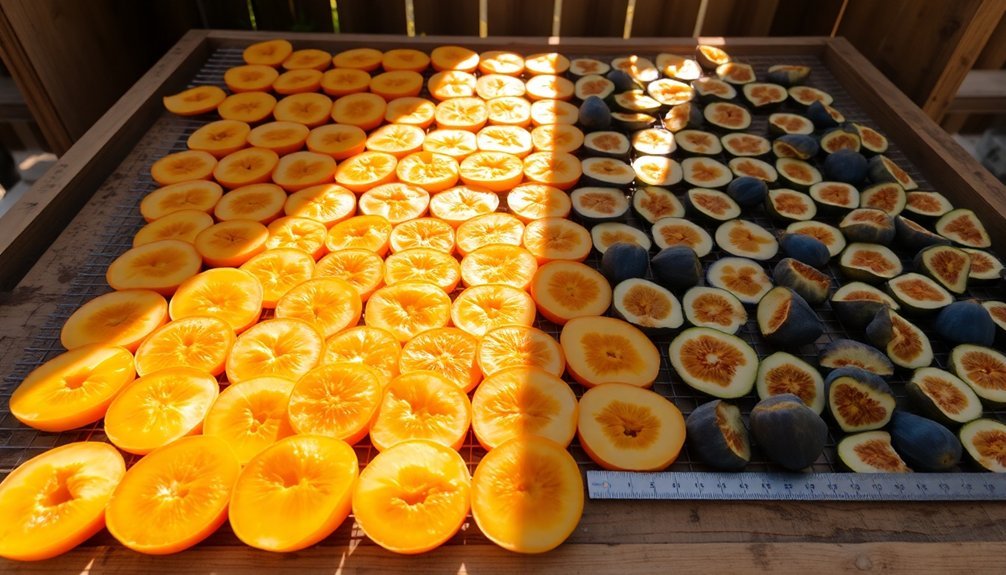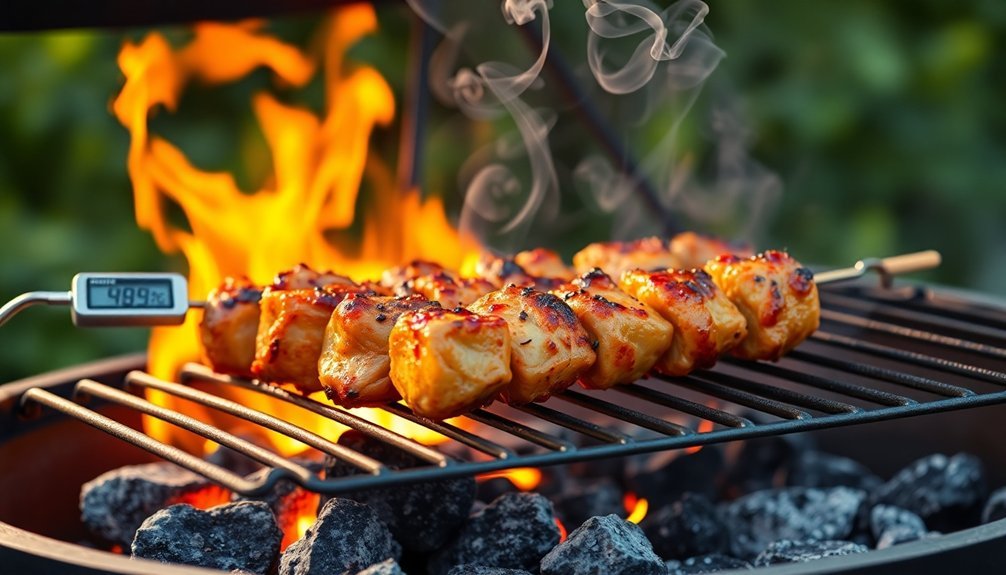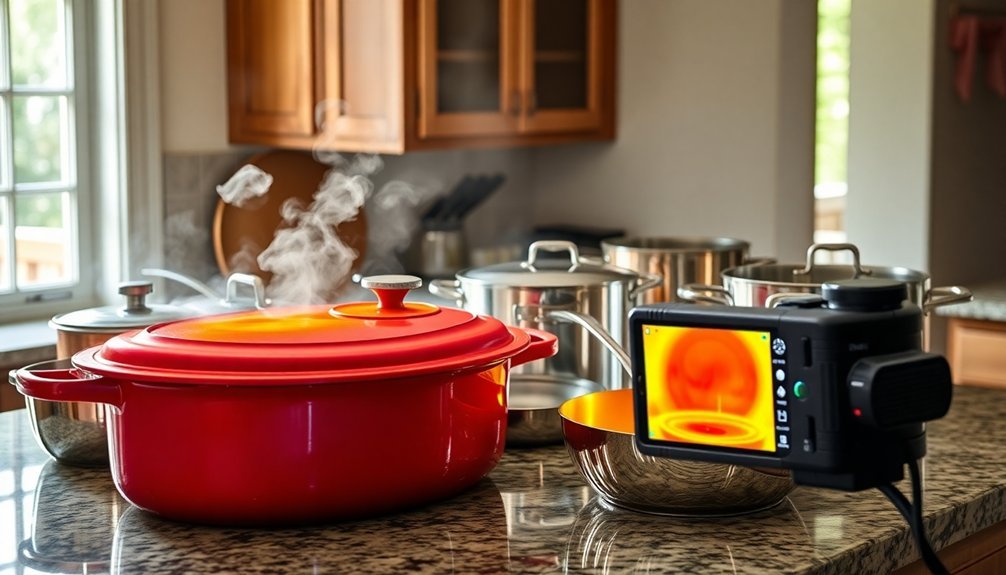For sun-dried fruit treats, you'll want to slice most fruits into uniform pieces between 1/8 to 1/4 inch thick. Cut apples into rings or wedges at 1/4 inch, and bananas into 1/8-inch coins. Small fruits like berries can stay whole or be halved, while larger fruits need thinner slices for proper drying. Don't overlap pieces on your drying rack, and use nonstick cooking spray to prevent sticking. Your cuts' consistency will directly impact drying time – thinner slices dry faster, typically taking 2-3 days, while thicker pieces need 4-6 days. There's much more to mastering the perfect cut for sun-dried treats.
Optimal Fruit Slicing Measurements

When preparing fruits for sun drying, precise measurements in your slicing technique will determine the success of your final product.
You'll want to cut your fruit into consistently sized pieces – whether you're making rings, wedges, or chips. For ideal drying, slice apples and similar fruits into 1/4-inch thick pieces, while bananas work best as 1/8-inch coins.
If you're working with whole fruits, you'll need to "check" or crack their skins to speed up the drying process. Sun drying works best with high sugar fruits that naturally resist spoilage.
Remember that thinner slices will dry faster and more evenly than thick ones. Before placing your fruit on the drying rack, spray the surface with nonstick cooking spray to prevent sticking.
Keep each piece separate from others to guarantee proper airflow and uniform drying throughout the process.
Understanding Thickness and Drying Time
Since thickness directly impacts drying time, you'll need to master the relationship between these two essential factors. Thinner, uniform slices (1/8 to 1/4 inch) will dry faster and more evenly than thick or whole pieces. You'll get the best results by ensuring consistent thickness across all your fruit pieces to prevent uneven drying. Maintaining optimal drying temperature of 140°F provides the most efficient results for dehydrating fruits.
| Thickness | Drying Method | Estimated Time |
|---|---|---|
| 1/8 inch | Dehydrator | 6-10 hours |
| 1/4 inch | Dehydrator | 12-18 hours |
| 1/8 inch | Sun Drying | 2-3 days |
| 1/4 inch | Sun Drying | 4-6 days |
| Whole | Any Method | Up to 36 hours |
Remember to check your fruits every 3-4 hours, rotating pieces as needed. You'll know they're done when cut pieces show no visible moisture inside.
Fruits That Need Special Sizing

When you're working with berries and small fruits, you'll want to leave them whole since cutting them too small can lead to over-drying.
You'll find that larger tropical fruits need careful sizing – cut them into uniform slices or chunks to guarantee even drying throughout. Experienced producers ensure fruits are harvested at peak ripeness before processing.
Remember that consistent sizing helps maintain quality and prevents some pieces from drying faster than others, which can affect your final product's texture.
Berries and Small Fruits
Although berries and small fruits are compact by nature, they require special attention to serving sizes when dried. You'll find that dried portions are typically half the size of fresh ones – a ¼ cup of dried berries equals ½ cup of fresh fruit for an adult serving.
When preparing berries for drying, you don't need to blanch them first. You can dry them whole or halved, depending on their size.
For successful sun drying, choose days when temperatures reach at least 85ºF with humidity below 60%. You'll need to spread the berries individually or in clusters and protect them from moisture by bringing them in at night.
Store your dried berries in airtight containers to maintain freshness. If they're sticking together, you can dust them with rice flour or corn flour.
Large Tropical Fruit Cuts
Large tropical fruits require specific cutting techniques for successful sun drying. You'll need to slice them into uniform pieces that allow for even drying while maximizing sun exposure.
For mangoes, pawpaws, and guavas, verify you're working with firm, ripe specimens and use a sharp stainless steel knife for clean cuts.
- Cut mangoes into thin, uniform slices or strips, maintaining consistent thickness for best drying. Don't exceed 1/4 inch thickness.
- Slice bananas lengthwise into thin sections, verifying each piece has similar dimensions for even dehydration.
- Cube larger fruits into manageable sizes, but remember that smaller, uniform pieces will dry faster and more consistently.
Before arranging your cut fruits on drying trays, dip them in a lemon juice solution (1:20 ratio) to prevent browning.
Basic Equipment for Proper Cuts
When setting up your fruit-drying station, you'll need sharp knives, a mandoline, and a reliable corer as your primary cutting tools to achieve consistent results.
Your cutting surface matters just as much, so choose a stable wooden or plastic board that won't dull blades or harbor bacteria.
To guarantee uniform drying, you'll want to measure your fruit slices carefully, aiming for even thickness that allows proper air circulation during the drying process.
Essential Cutting Tools Needed
Proper fruit preparation for sun-drying begins with four essential cutting tools that'll guarantee clean, consistent results.
You'll need a sharp chef's knife for larger fruits, a paring knife for precise cuts, and a serrated knife for tackling tough-skinned fruits. Always pair these with a sturdy cutting board featuring juice grooves to keep your workspace clean.
- Use corers and melon ballers to remove unwanted fruit parts efficiently, ensuring uniform pieces that'll dry evenly.
- Keep a vegetable peeler handy for fruits that need skinning before the drying process.
- Don't forget your safety equipment – cutting gloves will protect your hands while handling sharp tools.
Remember to sanitize all your tools before and after use to maintain food safety standards and prevent cross-contamination.
Measuring For Perfect Slices
Success in sun-drying fruits depends heavily on precise measurements and cuts. You'll need to maintain a consistent thickness of no more than ¼-inch at the widest point to guarantee even drying throughout your fruit pieces.
For the best results, use sharp cutting tools to slice your fruits in ways that maximize drying surface area. You can cut them into rings, wedges, or halves depending on the type of fruit.
If you're working with whole fruits, you'll need to crack their skins by blanching them first – just boil and shock them in cold water.
When arranging your slices on drying trays, place them in a single layer without touching or overlapping. If you're concerned about sticking, especially with sugary fruits, spray your trays with nonstick cooking oil before arranging the pieces.
Chopping Board Selection Tips
Selecting the right cutting board forms the foundation for precise fruit slicing in your sun-drying journey. You'll want a sturdy maple or walnut board that's at least 12 by 18 inches to give you plenty of space for consistent cuts.
When preparing multiple fruits, a thick board measuring 1.5 inches or more will provide stability and prevent warping as you work through your batches.
- Choose end-grain construction for better durability and knife protection during repetitive slicing.
- Look for boards with juice grooves to catch excess moisture from ripe fruits.
- Consider models with non-slip feet to keep the board steady while cutting through firm fruits.
Remember to maintain separate boards for fruits and other foods to prevent flavor transfer and cross-contamination.
Keep your board clean and thoroughly dried between uses to extend its life.
Small Fruits Versus Large Fruits

When choosing fruits for sun-drying, size plays an essential role in both the process and outcome. Small fruits like berries and halved apricots dry faster and more evenly, often without requiring pretreatments. You'll know they're ready when they rattle during a shake test. For larger fruits like apples and bananas, you'll need to slice them into uniform rings, wedges, or chips to achieve ideal results.
| Characteristic | Small Fruits | Large Fruits |
|---|---|---|
| Prep Method | Whole or halved | Thin slices required |
| Drying Time | Faster | Longer |
| Pretreatment | Rarely needed | Often needed |
| Skin Handling | Leave as is | May need removal |
While you can leave skins on larger fruits, they'll dry more slowly. Consider using ascorbic acid on bigger fruits to prevent darkening during the drying process.
Common Fruit Sizing Mistakes
To achieve perfectly sun-dried fruits, you'll need to avoid several common sizing mistakes that can derail your efforts. Many people make the error of cutting fruits too large or failing to maintain uniform sizes, which leads to inconsistent drying and potential spoilage.
- If you're working with tomatoes or peaches, don't just cut them in half – slice them into smaller, uniform pieces to guarantee even drying and prevent rotting.
- You'll need to remove seeds and pits before drying, as these can interfere with the process and create uneven results.
- When placing fruits on drying racks, make sure they don't overlap or touch each other, as this prevents proper air circulation and can lead to spoilage.
Remember that consistent sizing is essential for achieving high-quality dried fruits that will store well.
Best Shapes for Even Drying

Now that you've mastered proper sizing, the shape of your fruit pieces will make a significant difference in achieving ideal results.
You'll want to slice your fruits thinly between 1/8″ to 1/4″ inch, creating uniform pieces that dry at the same rate.
Cut your apples into rings, wedges, or chips, and slice bananas into coins or sticks. For faster drying, opt for thin, peeled slices over whole fruits. If you're drying whole fruits, you'll need to crack their skins through a quick boiling and cold water treatment. Remember to remove seeds and pits to prevent uneven drying.
Arrange your pieces in single layers on elevated trays with good air circulation, and don't let them overlap. For protection against browning, pretreat your fruit with ascorbic acid, lemon juice, or red wine vinegar.
Testing Your Fruit Cut Accuracy
Before proceeding with the drying process, you'll need to confirm that your fruit pieces meet the proper cutting standards. Your cuts should result in uniform pieces that'll dry evenly and maintain proper texture throughout the process.
Test your cut fruit pieces for consistency and proper sizing using these essential checks:
- Choose several sample pieces and fold them in half – they shouldn't stick together or show signs of excess moisture when pressed.
- Compare the thickness of multiple pieces by stacking them side by side – look for uniform dimensions that'll guarantee even drying across all pieces.
- Check each piece's flexibility by gently bending it – properly sized cuts will be pliable without breaking or crumbling.
Remember that consistent cuts lead to uniform drying, which helps prevent some pieces from becoming overly dry while others remain too moist.
Frequently Asked Questions
Can I Mix Different Fruit Sizes on the Same Drying Tray?
You shouldn't mix different fruit sizes on one tray as they'll dry at different rates. It's best to group similar-sized pieces together to guarantee even drying and prevent potential spoilage.
How Do Seasonal Changes Affect Recommended Fruit Cutting Sizes?
You'll want smaller cuts in summer when days are longer and temperatures higher. In less predictable seasons, cut fruits larger to accommodate potential weather delays and shorter drying windows.
Should Fruit Be Cut Differently When Drying for Smoothies Versus Snacking?
You'll want smaller pieces (about 1/4 inch) for smoothies since they'll blend easier. For snacking, cut fruits into larger pieces (1/2 to 1 inch) to create satisfying, bite-sized treats.
Do Organic and Conventional Fruits Require Different Sizing Approaches?
You'll use the same sizing guidelines for both organic and conventional fruits. Since organic fruits don't contain preservatives, you'll want to guarantee uniform, thin slices to achieve thorough drying and prevent spoilage.
Can I Use Frozen Fruit, and Does It Need Different Size Considerations?
You shouldn't use frozen fruit for sun drying as it's too moisture-heavy. If you must, thaw it completely and cut it into thinner slices than fresh fruit to help combat the extra moisture content.
In Summary
You'll get the best results by cutting most fruits into 1/4-inch thick slices or pieces. Remember that berries and grapes can be left whole, while larger fruits need consistent, thin cuts for even drying. Keep your sizing uniform, avoid pieces thicker than 3/8-inch, and you'll achieve perfectly dried treats every time. If you're uncertain, test a few pieces before preparing your entire batch.





Leave a Reply